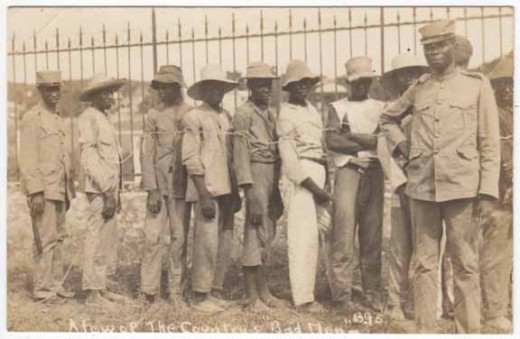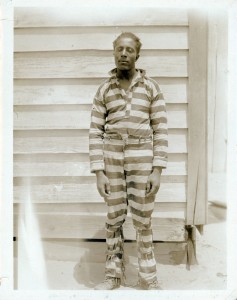The Anguilla Prison Camp Massacre…
On July 12 1947, an article was published in the New York Times under the headline “Five Convicts Slain in Break in Georgia.” It opened with the following sentence:
“Five Negro convicts were shot to death and eight others were wounded, two critically, in an escape attempt at a state highway work camp today, Warden H. G. Worthy said.”
The words are unremarkable on their face. In fact, many prisoners tried to escape from convict camps over the years. Camps were brutal and terrible places for prisoners. However the initial account of what happened at the Anguilla Prison Camp (near Brunswick, Georgia) on July 11, 1947 turned out to be completely fabricated. Warden H. G. Worthy provided his initial version of events which was published in the Times:
A group of new prisoners joined the camp yesterday and were sent out today to work on the Jesup Highway. The new men refused to work and were brought back to the camp about 4 p.m. They would not get out of the trucks when ordered and Warden Worthy called county police.
Chief of Police Russell B. Henderson of Glynn County talked to the prisoners and told them to do what the warden ordered, “cut out that foolishness.”
The men left the trucks and were lined up in the prison enclosure. When the police chief finished talking to them they broke, ran to the barracks and dove under the building, which is about two feet off the ground. The prisoners crawled on under the building and ran toward the fence enclosure on the other side.
Officers then opened fire with shotguns and rifles. Five were killed and eight were wounded. Fourteen prisoners came back and surrendered.
All told eight black men would be killed. Over the next few months, the Warden’s initial account of an attempted mass escape would prove to have been a lie. It turns out that what took place at Anguilla was a cold-blooded massacre of prisoners.
Immediately after the incident, some prisoners told a story of a drunk warden and others gunning people down in cold blood. Only three days later, the Times was reporting that a grand jury investigation was scheduled to open to scrutinize the killings at the camp. The assistant director of the State Department of Corrections, J.B. Hatchett was quoted as saying that “his investigations of the shootings had led him to the conclusion that Warden W. C. Worthy was not drunk and had not been drinking, as charged by a Negro convict at a coroner’s jury investigation Saturday.”
Case closed, right? No, actually things were just getting started.
On July 18, a grand jury exonerated Warden Worthy and five guards suggesting that they were justified in their actions. In defending himself, Worthy told the grand jury that a convict named Willie E. Bell tried “to charge and disarm him.” Worthy shot him in the leg. Mr. Bell however gave a different story. He “testified that Warden Worthy was ‘half drunk’ and ‘wanted to kill me’.”
This incident captured national attention and generated several protests across the country. Later, it came to light that prison guards had in fact “ordered the Negro prisoners unto a ditch occupied by poisonous snakes.” They were ordered to do this without any shoes. Some prisoners refused. For this, they were shot at and some killed. It was a massacre.
Sam Levine, Glynn County Commissioner, testified at a hearing of the State Board of Corrections in August 1947 and filled in the story of what actually happened at the Anguilla Prison Camp. The State Board was considering the recommendation to abolish the Georgia highway convict camp system in the aftermath of the Anguilla massacre. The Times reported on Levine’s testimony:
“There was no justification for the killings,” he declared. “The chief of county police and two policemen were there, but they didn’t see any reason to shoot the prisoners. They had tear gas guns they could have used.
“I saw the Negroes where they fell. Two were killed where they crawled under the bunkhouse and two others as they ran under their cells. The only thing they were trying to escape was death. Only one tried to get over the fence.”
Levine rejected the contention that the prisoners were planning an escape. He said that had they really wanted to escape, they could “have overpowered their two guards on the road instead of waiting until they were back in the barracks surrounded by guards and police all heavily armed.”
The State Board of Corrections concluded that the Grand Jury conducted a “one-sided whitewash investigation” of the Anguilla Prison Camp massacre. It ordered a new inquiry and abolished the camp. They ordered that the remaining seventy prisoners be transferred to other camps or to the State Prison.
In October 1947, the warden and four guards were indicted by a Federal Grand Jury under civil rights statutes. They were charged with depriving eight dead prisoners of their constitutional right “to be secure in their person while in the custody of the State of Georgia and to be immune from illegal attack at the hands of officers and employees of the State of Georgia while in custody, and not to be subjected to punishment without due process of law.”
When the trial began on October 27, some prisoners testified that “threats” were “made against prisoners engaged in road work after the convicts declined to work in ditches they said were filled with water and snakes.” Those who refused to work were then returned to the camp and shot by the Warden and guards. Vance Mitchell, the defense attorney, contended that “the men in the detail were rapists, murderers and burglars and all but one had escaped on previous occasions.” He said: “The guards fired upon the convicts in defense of their own lives.”
On November 4th after deliberating for 8 minutes, the jury found all five men not guilty of the charges against them. One of the main reasons that this case went to court was because of the tireless work of the NAACP in documenting the injustice. I am working on several upcoming projects and I look forward to sharing some of them with you here. Currently I have been doing some research about lynching and it was in the course of that work that I stumbled upon the story of the Anguilla Prison Camp massacre. In the coming weeks, I will share more about the massacre as I am still waiting for some information from NAACP files.
Prison Culture will be back on January 1, 2013. Merry Christmas and Happy New Year!


